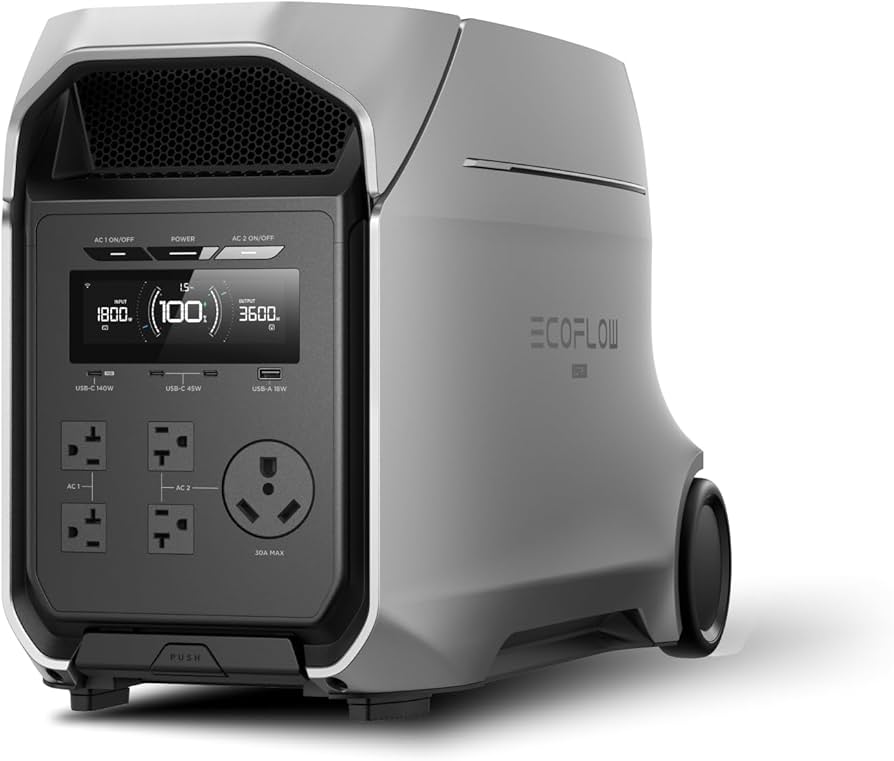

EcoFlow has a habit of releasing very capable power stations with incredibly confusing names. The EcoFlow DELTA 3 Ultra Plus continues the tradition: it’s powerful, sleek, expandable… and continues EcoFlow’s naming system that seems to make absolutely no sense anymore but them.
Confusing names aside, this new power station is the biggest and most capable in the DELTA 3 lineup. If you need more power, you’d need to jump into the heavier-duty DELTA Pro family. From first glance, it’s a modular and portable power station that has a high battery capacity and powerful inverter, but is it actually any good?
To find out, we put the new DELTA 3 Ultra Plus through a variety of real-world testing, including checking the charging speeds, inverter efficiency, idle draw observations, surge behavior, and overall usability. And after all that, we’re ready to give you our honest take on EcoFlow’s newest “3-Ultra-Plus-Max-Classic-Whatever” release.
Let’s get into it.
Before we jump into all of our testing, as well as the things we like and dislike about this new EcoFlow power station, here’s a quick overview of what it’s supposed to bring to the table:
{{review-summary}}
Just like every portable power station we get our hands on, we wanted to put the DELTA 3 Ultra Plus through its paces by running it through a variety of tests. Here’s what we found:
The unit achieved about 85% efficiency, which is excellent for a power station with a 3,600W inverter. Since we normally give anything over 80% an A, we’ll say the DELTA 3 Ultra Plus scores an A+. Not quite as impressive as the DELTA Pro 3, but still really good.
Testing the idle consumption was a little more difficult. Since the DELTA 3 Ultra Plus has two independent inverters, one for the main ports and the other for that true 30A plug, we measured idle draw with everything active, and then with the high-output side turned off.
We calculated an idle power draw of about 24W per hour with both sides of the inverter switched on. When we switched off the 30A outlet, meaning only the standard AC plugs and USB ports were receiving power, the idle draw was 22W per hour.
That’s not a massive difference, but it still would be worth switching off the inverter for the 30-amp plug if you didn’t need it. Either way, a maximum idle draw of just 24W is perfectly acceptable for a unit in this output class.
This is one area EcoFlow has clearly improved things for their portable power stations. The DELTA 3 Ultra Plus runs much quieter than older EcoFlow models, like the DELTA 2 Max.
In terms of operating volume, it’s actually similar to the DELTA Pro Ultra, which is pretty amazing given it’s amongst the quietest power stations we have ever tested. Even when you’re pushing this thing’s inverter to its maximum output, the fans never become intrusive.
For those looking for a power station they could use inside their home, RV, or pretty much any other type of living space, this unit would be a practical choice.
The DELTA 3 Ultra Plus works well as a backup UPS. We could charge it at 1,800W from the wall while simultaneously pulling roughly 3,000W out of the unit without tripping anything. Many power stations limit you to the input wattage when outputting, but this EcoFlow power station does not.
The unit surges well, especially when you are using the 30A RV plug. In fact, that 30A output seems to be rated for stronger surge bursts than the standard AC outlets.
One weird thing we noticed was the fact that the unit always seems to shut down the 30A port first when you overload the unit. It’s a bit strange, but we’ll talk about that a little more later.
Before we even get into all of the things we like and dislike about this unit, we need to address the obvious: EcoFlow’s naming system has completely spiralled out of control.
The company now splits its lineup into two major families: the DELTA Pro Series and the standard DELTA lineup, but even having two main categories barely helps. Under the DELTA Pro side, you’ll find the original EcoFlow DELTA Pro, DELTA Pro 3, and DELTA Pro Ultra.
On the standard DELTA side, you get the DELTA, DELTA 2, and DELTA 3, but then you have to step into the subcategory chaos.
Within the DELTA 3 family alone, EcoFlow offers the DELTA 3 Classic, DELTA 3, DELTA 3 Plus, DELTA 3 Max, DELTA 3 Max Plus, DELTA 3 Ultra, and finally the DELTA 3 Ultra Plus we’re looking at today.
Once upon a time, labels like “Max,” “Plus,” and “Ultra” actually meant something. Today, they feel more like the solar generator version of “Extra Strength Tylenol”, where everything sounds stronger, but it all starts to blend together.
That said, the DELTA 3 Ultra Plus does sit at the top of the entire DELTA 3 range. Unless they launch something new, like an EcoFlow DELTA 4, you have to step into the world of the DELTA Pro series if you want to get anything bigger than this unit.
Now that we’ve got the naming confusion off our chest, let’s take a look at all of the things we liked about this new power station:
EcoFlow borrowed the premium rolling design from the DELTA Pro series, and we’re really glad they did. With rubber wheels and a sturdy suitcase-style handle, they managed to make this 74-lb heavyweight feel more like a classic EcoFlow portable power station.
It’s also worth noting that the wheels being rubber, rather than plastic, is a nice touch. It makes it much quieter to pull indoors, and it offers the unit some better protection when you go over any sort of bumps or uneven surfaces.
When we were pulling it, we found that it rolls nicely, doesn’t rattle, and genuinely feels like a really well-built power station.
One of the standout features of the DELTA 3 Ultra Plus is its seamless compatibility with most of the EcoFlow “EcoSystem” accessories. Unlike most brands that lock you into specific expansion batteries, EcoFlow even allows backwards compatibility, meaning this unit can connect to its own expansion batteries, as well the following older batteries:
You can also power it with the EcoFlow Smart Gas Generator, which is another huge plus for automatic start/stop behavior during outages.
If you’re someone who already owns EcoFlow gear, this backwards and cross-platform compatibility helps you upgrade your power station, without having to worry that all of your old equipment will become obsolete.
For a major player like EcoFlow to care enough to ensure buyers can use old gear is really impressive. Most companies want you to start fresh, as it means you’ll end up buying more stuff from them.
The DELTA 3 Ultra Plus gave us reliably strong results: high efficiency, low idle power draw, great inverter performance, and quiet operation. In real-world use, it feels like a refined and matured EcoFlow power station, not a rushed product.
Seems like pretty standard praise for a power station that will run you nearly $1,500, but you’d be surprised how many products we see launched in this category that don’t deliver.
Clean, modern, DELTA Pro-style redesign. It’ll look good in a garage, RV, or even inside your home's main living space.
The 120V outlets were also rotated, which means plugged-in cords won’t overlap and block other outlets. Even the 30A port is finally placed in a way that doesn’t interfere with anything else, unlike several competing units.
The display screen is also really bright and crisp, making it readable outdoors, even on bright days. The EcoFlow app also remains one of the best in the industry. It’s just a very user-friendly power station that looks great and performs exactly as it should.
While there was a lot to like about this unit, there’s no such thing as a perfect power station. Here are a few of the issues we found:
This thing weighs 74 pounds. While the wheels help, they aren’t going to do much if you’re hauling it up a staircase in the dark during a blackout. This is where a built-in LED would be incredibly helpful.
This isn’t anything new, as EcoFlow seems to flat out refuse to add lights to their power stations (aside from on the EcoFlow RIVER 3 Plus). Anker is much better at this, and the Anker SOLIX C800X is a perfect example.
It’s such a simple feature that we strongly believe would help a lot of people. Whether you’re camping or facing a power outage, a light would be helpful. By the way, “just get a headlamp” is not a practical solution.
The dual-inverter layout creates a weird quirk: if the unit surges past 3,600W, only the 30A side shuts off, even if the overload happens on the 120V outlets.
This two-button inverter system is a cool idea, but the way the unit trips is just plain weird. A few viewers on our YouTube channel have since claimed that you can reverse this in the app, but it’s still a strange issue. If you had this power station tied into your home’s main transfer switch, it would cause all kinds of issues.
EcoFlow designed it in a way that it can stand upright, just like the Anker SOLIX F3000, but unlike the Anker power station, EcoFlow didn’t add rubber bump-stops. So, if you stand it up vertically, you risk scratching the plastics on an otherwise great-looking unit.
When you invest so much time and effort into designing such an aesthetically pleasing power station, why wouldn’t you want to protect it? It’s a minor thing, but a gripe nonetheless.
This might be the strangest thing about this unit: the original EcoFlow DELTA Pro is usually cheaper than the DELTA 3 Ultra Plus. For slightly less money, the old DELTA Pro gives you:
It’s an odd overlap, and depending on your needs, the more powerful DELTA Pro may make far more sense. It’s still a great release, but with the older unit coming in at roughly $100 less, it’s a weird one.
The DELTA 3 Ultra Plus fills a very specific role in an already crowded EcoFlow power station lineup: high-powered 120V backup and portable energy, without stepping into 240V whole-home territory.
It’s perfect for someone who:
It’s not for someone who:
In those cases, we’d probably recommend going with the original EcoFlow DELTA Pro we mentioned above.
The EcoFlow DELTA 3 Ultra Plus is a solid, well-built EcoFlow power station that gave us some excellent test results. It’s perfect for high-powered portability and moderate emergency backup. Plus, it looks amazing.
However, depending on your power needs, the price may push you toward the original DELTA Pro instead. If you’re unsure which model is actually right for your setup, take our Power Station Quiz, which will give you an instant recommendation based on your real usage.
